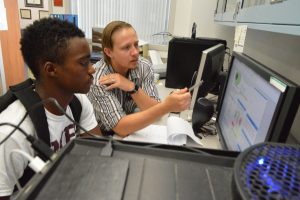 We have built a pathway program that develops students (‘scholars’) from low-income and educationally under-resourced backgrounds into successful professionals. Our scholars specifically have an interest in pursuing health care, biomedical and STEM careers. Many are already pursuing training for these career paths, but require additional educational development and mentorship to ensure that they are ready for doctoral level programs at Johns Hopkins University School of Medicine and elsewhere. To expand the pool of successful professionals, we also need to develop scholars beginning at a younger age; therefore, our initiative includes programs for fifth grade, high school, undergraduate, and post-baccalaureate levels.
We have built a pathway program that develops students (‘scholars’) from low-income and educationally under-resourced backgrounds into successful professionals. Our scholars specifically have an interest in pursuing health care, biomedical and STEM careers. Many are already pursuing training for these career paths, but require additional educational development and mentorship to ensure that they are ready for doctoral level programs at Johns Hopkins University School of Medicine and elsewhere. To expand the pool of successful professionals, we also need to develop scholars beginning at a younger age; therefore, our initiative includes programs for fifth grade, high school, undergraduate, and post-baccalaureate levels.
To be considered low-income, scholars come from households with incomes <200% of the federal poverty limit, though many scholars fall well below the poverty limit. To be educationally under-resourced, scholars must be first generation college and/or have been directed to high schools with greater than 50% of the student body on the Free and Reduced Meals program (FARM; most scholars come from schools with >~95% of the students on FARM). Many of our scholars also come from households characterized by one or more of the following: single parent household, parent struggling with addiction or incarceration, abuse at home, or homelessness. To identify our younger cohort of scholars, we work with several close partnering organizations in Baltimore (e.g. Boys Hope Girls Hope of Baltimore, SEED School of Maryland, Green Street Academy, Baltimore City College, Dunbar High School, and Baltimore Polytechnic High School among many others). We conduct national searches for our undergraduate and post-baccalaureate arms of our program.
 Our program is structured to develop scholars’ hard academic and technical skills, professionalism, and a list of tangible accomplishments. We achieve these goals through mentored research and structured academic training. We draw upon our scientific enterprise, endowed with phenomenal doctoral and postdoctoral trainees, staff, and faculty to deliver our programs. We provide exposure to role models who are highly successful underrepresented in science or medicine faculty physician scientists and scientists. We also provide preparation for standardized tests to aid our scholars as they seek admission into medical and graduate school.
Our program is structured to develop scholars’ hard academic and technical skills, professionalism, and a list of tangible accomplishments. We achieve these goals through mentored research and structured academic training. We draw upon our scientific enterprise, endowed with phenomenal doctoral and postdoctoral trainees, staff, and faculty to deliver our programs. We provide exposure to role models who are highly successful underrepresented in science or medicine faculty physician scientists and scientists. We also provide preparation for standardized tests to aid our scholars as they seek admission into medical and graduate school.
Annually, our pathway initiative is geared to serve ~18 fifth graders through our Fun with Science Camp, ~30 high school students through the Summer Academic Research Experience (SARE) and Biophysics Research for Baltimore Teens (BRBT). We also serve ~16 undergraduates through our CSM Summer Internship Program and ~10 post-baccalaureate scholars through our Doctoral Diversity Program (DDP). Scholars are compensated with a stipend that makes it financially feasible for them to participate; however, the stipends must be earned and the bar is set high.
Our programs are making transformative impact. Of the ~220 high school-level scholars, >83% who have reached college age have entered college, and 73% have chosen STEM or health-related career paths. Moreover, we have documented considerable growth in our high school scholars. This growth includes >2 grade-level improvement in writing skills over our 8-week program, quantitative improvement in mathematics skills, and in many cases, more than one full point increase in grade point average upon returning to high school. Two high school scholars have co-authored scientific publications. Because of the nature of our recruiting mechanism, all CSM SIP and DDP scholars are STEM majors, and all are extremely likely to matriculate into medical or graduate doctoral programs. In fact, 83% of our post-baccalaureate students have been accepted into MD, MD-PhD, and PhD programs at a variety of institutions, including Stanford, Harvard, Johns Hopkins, Emory, Vanderbilt, University of Chicago, Albert Einstein, Tufts, Mayo Arizona, Washington University in St. Louis, Kennesaw St., Ohio State among many others. Our DDP have also co-authored >40 publications to date, a number that is rapidly increasing.